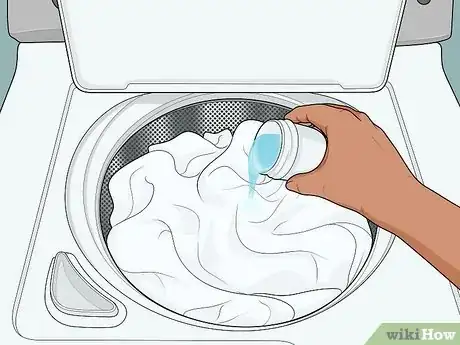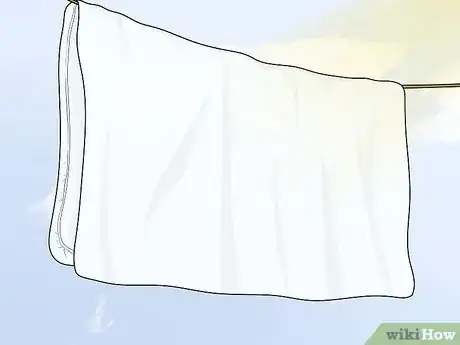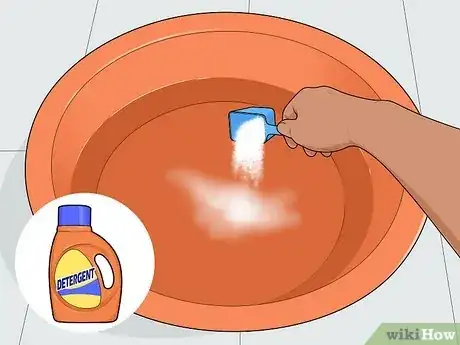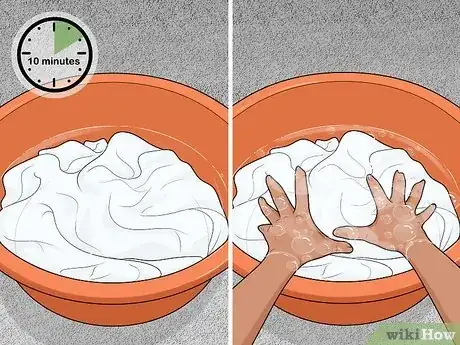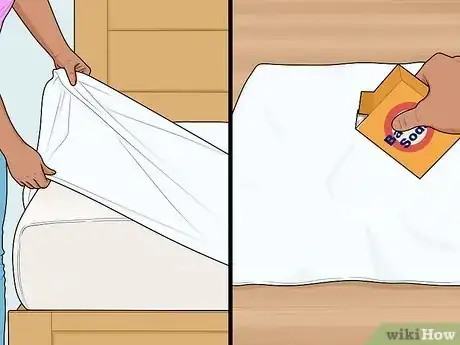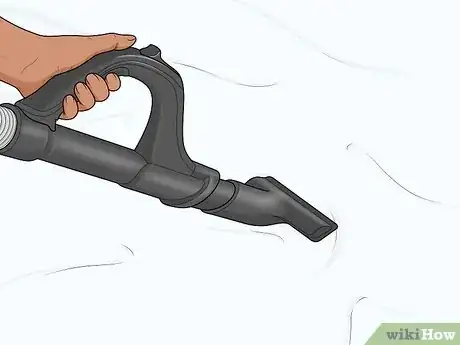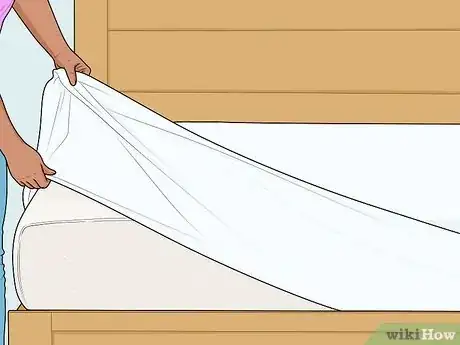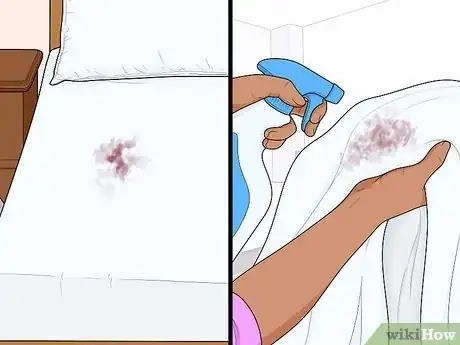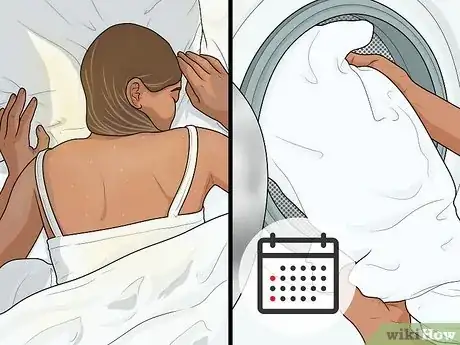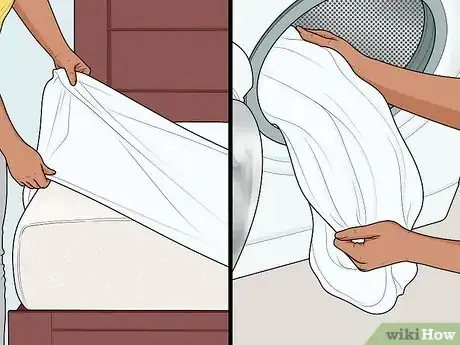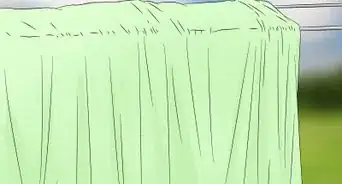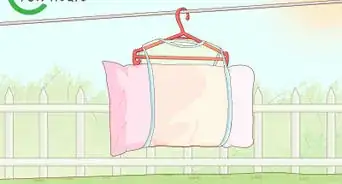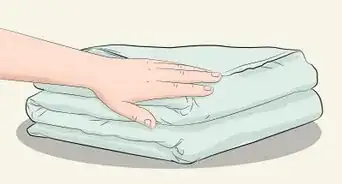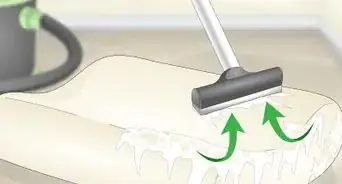This article was co-authored by wikiHow staff writer, Luke Smith, MFA. Luke Smith is a wikiHow Staff Writer. He's worked for literary agents, publishing houses, and with many authors, and his writing has been featured in a number of literary magazines. Now, Luke writes for the content team at wikiHow and hopes to help readers expand both their skillsets and the bounds of their curiosity. Luke earned his MFA from the University of Montana.
There are 7 references cited in this article, which can be found at the bottom of the page.
This article has been viewed 1,329 times.
Learn more...
Mattress protectors offer a handy layer of protection between you and your mattress, but it’s easy to forget about them since they hide under your normal sheets. They’re a bit different from your other bedding, and sometimes require a particular washing method. We’ve laid out an easy guide on how to machine- and hand-wash a mattress protector, how to remove stains, how often to wash it, and how to freshen it up even when it doesn’t need a full wash.
Things You Should Know
- Check your mattress protector’s cleaning label for washing instructions.
- Wash your mattress protector in the washing machine on a high temperature with a detergent.
- Hand-wash your mattress protector in a large plastic bin with warm water and a mild detergent.
- Tumble dry your mattress protector on low heat, or let it air dry for a few hours.
Steps
Machine Washing a Mattress Protector
-
1Read the washing instructions on the mattress protector’s label. Just like a comforter or pillow, your mattress protector should have washing instructions on a sewn-in tag that will tell you exactly how to wash it. Make sure your protector is machine washable, then follow the instructions to determine water temperature, spin speed, and drying methods.[1]
- A symbol that resembles a cup filled with water indicates the protector is machine washable. If the symbol has an X through it, it is not machine washable.[2]
- Avoid machine-washing and drying waterproof mattress protectors, unless the label indicates otherwise. These protectors often have a vinyl layer that may melt in the machine.[3]
-
2Place the mattress protector in the washing machine with a mild detergent. Use the amount of detergent recommended on the detergent label for heavy loads, usually about a capful.[4]
- For added freshness, add a tablespoon of borax powder to the machine for a white mattress protector, or a tablespoon of baking soda for a colored mattress protector.[5]
Advertisement -
3Run the machine on a hot cycle. Consult the care label for washing temperature, but if not temperature is listed, run the machine on the hottest setting possible in order to kill any bacteria in the protector. [6]
-
4Tumble dry or air dry your mattress protector. If the label indicates the protector can be tumble dried–indicated by a circle symbol inside a square–run the protector on a low-heat drying cycle, and repeat as needed until the protector is dry. If the circle symbol contains a single dot, use low heat. Two dots inside the circle means to use high heat. If the square-and-circle symbol is marked with an X, air dry instead.[7]
- To air dry, hang the protector on an outdoor clothesline, an indoor drying rack, or from a high dresser for a few hours. Then, flip and let it dry for a few more hours before you replace it onto your mattress.[8]
Hand-Washing a Mattress Protector
-
1Fill a large container with water and detergent. Find a large plastic bin or other basin and position it on a lawn outside or indoor near a sink. Fill it with enough warm water to submerge the protector (you can add more water later), and as much gentle detergent as you would use in a washing machine (about a teaspoon for every gallon of water).[9]
- You can also use your bathtub, if you don’t mind cleaning it after you was your protector.
-
2Submerge the mattress protector for 10 minutes, then squeeze it. Let the protector sit and soak up the soapy water for a while. Then, with your hands, press the mattress protector down against the bottom of the basin to force any dirt or debris from the fabric. Repeat this motion several times (for about 15-20 minutes total), turning the protector between each squeeze.[10]
-
3Empty the basin’s water, then hand-wash again. After several minutes or once the water becomes murky, find a grassy place to tip the dirty water out, or have someone help you tip the water into a kitchen sink. Then refill the basin’s warm water (skip the detergent this time) with the protector still inside and repeat the squeezing motion several more times, until no more suds are released.[11]
- You may need to empty and refill the basin multiple times, depending on how dirty the mattress protector is.
-
4Wring out the water from the mattress protector and let it air dry. Over grass or a kitchen sink, gently wring out the moisture from the mattress protector. Then, unfurl it and hang the protector on an outdoor clothesline, an indoor drying rack, or from a high dresser for a few hours. Then flip the protector and let it dry for a few more hours before you replace it onto your mattress.[12]
Freshening Up Your Protector (Without Washing It)
-
1Sprinkle baking soda over the flattened mattress protector. Strip the mattress protector from your bed and lay it flat on a clean floor. Then, liberally sprinkle baking soda (about ½-1 box) over the entire surface of the protector, and let it sit for 24 hours. After, vacuum the baking soda off the protector, or vigorously shake the protector outside to remove the baking soda.[13]
- The baking soda will absorb any odors clinging to your mattress protector.
-
2Vacuum the mattress protector with an upholstery attachment. With the upholstery attachment of your vacuum (usually a flat attachment with red felt bristles), run the vacuum nozzle down the length of the mattress protector while the protector is still on your mattress.[14]
- Vacuuming is a good washing alternative if your mattress protector cannot be removed or if it cannot be machine-washed. You can also clean the mattress itself in this way.
Removing Stains from a Mattress Protector
-
1Remove the mattress protector from the mattress. It’s important not to clean the protector while it’s still on the mattress, if you can help it, since water and cleaning solution could soak through to the mattress and soil it or cause mildew.[15] Remove the mattress protector and bring it to a clean surface, like the top of a washing machine.
-
2Dampen the stain and apply a spot-treatment stain remover. Use a spray bottle to dampen the surface of the mattress protector, saturating the entire area of the stain. Then follow the instructions on the stain remover’s label to apply it to the stain and let it sit for the indicated amount of time. Finally, dampen the stain again and wipe the excess stain remover off with a damp cloth.[16]
-
3Wash the mattress protector and let it dry. Run the mattress protector through the washing machine or hand-wash it, then place it in the dryer if the label indicates it can be machine-dried. Otherwise, hang it in a room with plenty of air circulation for a few hours and let it dry completely before putting it back on your mattress.[17]
How often should you wash a mattress protector?
-
1Wash your mattress protector every 2 months. You don’t need to wash a mattress protector as often as you wash your other bedding, since there’s often at least one layer between your body and the mattress protector. Wash it every couple months to keep it fresh.[18]
-
2Wash your mattress pad weekly if you’re sick or have allergies or pets. Pets can contribute to dirt and oil buildup on your mattress, and if you have allergies or are ill you’ll want to be extra vigilant in keeping your protector fresh and free of allergens and bacteria. Wash your mattress protector more frequently according to any allergy symptoms; about every week is a good baseline.[19]
-
3Wash your mattress protector immediately after spills. It may have protected your mattress, but now you need to refresh it for the next spill. Strip the protector from your mattress and apply stain remover as soon as possible. Then for an extra measure, toss the protector into the washing machine or wash it by hand.[20]
-
4Wash your mattress protector every couple weeks if you have oily skin or sweat a lot. In these cases, you’re body releases more oils and particulates into your mattress than other sleepers. That’s totally fine, but wash your protector more frequently–about every 2 weeks.[21]
-
5Wash a guest-bedroom protector before and after your guests’ stay. Though these protectors aren’t getting much use, you’ll want to freshen them up immediately before your guests arrive, and then make sure they’re clean immediately after they leave.[22]
- If your guests are staying for an extended period, wash their mattress’ protector as often as a regularly used protector.
Things You’ll Need
- Mild detergent
- Stain remover
- Large plastic bin
- Baking soda
- Borax Powder
- Vacuum (optional)
References
- ↑ https://www.homesandgardens.com/interior-design/bedrooms/can-you-wash-a-mattress-cover
- ↑ https://www.cleanipedia.com/gb/clothing-care/washing-symbols-explained.html
- ↑ https://www.homesandgardens.com/interior-design/bedrooms/can-you-wash-a-mattress-cover
- ↑ https://www.toptenreviews.com/how-to-wash-a-mattress-protector
- ↑ https://www.lucehome.sg/blog-article/how-to-wash-a-mattress-cover#stronghow-often-should-you-clean-your-mattress-protectorstrong
- ↑ https://www.homesandgardens.com/interior-design/bedrooms/can-you-wash-a-mattress-cover
- ↑ https://www.homesandgardens.com/interior-design/bedrooms/can-you-wash-a-mattress-cover
- ↑ https://www.toptenreviews.com/how-to-wash-a-mattress-protector
- ↑ https://www.lucehome.sg/blog-article/how-to-wash-a-mattress-cover#stronghow-often-should-you-clean-your-mattress-protectorstrong
- ↑ https://www.lucehome.sg/blog-article/how-to-wash-a-mattress-cover#stronghow-often-should-you-clean-your-mattress-protectorstrong
- ↑ https://www.lucehome.sg/blog-article/how-to-wash-a-mattress-cover#stronghow-often-should-you-clean-your-mattress-protectorstrong
- ↑ https://www.lucehome.sg/blog-article/how-to-wash-a-mattress-cover#stronghow-often-should-you-clean-your-mattress-protectorstrong
- ↑ https://www.homesandgardens.com/interior-design/bedrooms/can-you-wash-a-mattress-cover
- ↑ https://www.homesandgardens.com/interior-design/bedrooms/can-you-wash-a-mattress-cover
- ↑ https://www.homesandgardens.com/interior-design/bedrooms/can-you-wash-a-mattress-cover
- ↑ https://www.homesandgardens.com/interior-design/bedrooms/can-you-wash-a-mattress-cover
- ↑ https://www.homesandgardens.com/interior-design/bedrooms/can-you-wash-a-mattress-cover
- ↑ https://www.goodhousekeeping.com/home/cleaning/a33897/how-often-to-wash-mattress-pad/
- ↑ https://www.goodhousekeeping.com/home/cleaning/a33897/how-often-to-wash-mattress-pad
- ↑ https://www.goodhousekeeping.com/home/cleaning/a33897/how-often-to-wash-mattress-pad/
- ↑ https://www.toptenreviews.com/how-to-wash-a-mattress-protector
- ↑ https://www.housedigest.com/979862/the-best-way-to-wash-your-mattress-protector/

